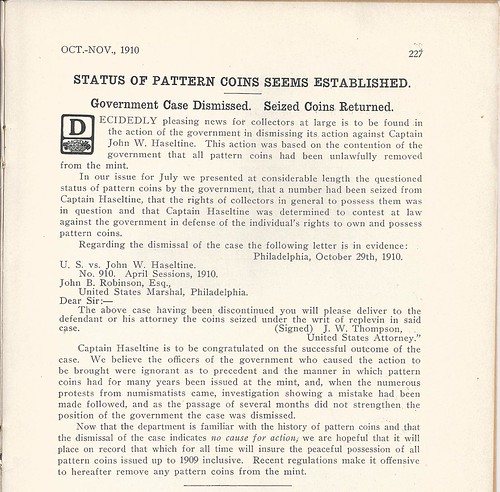
PREV ARTICLE
NEXT ARTICLE
FULL ISSUE
PREV FULL ISSUE
ON THE LEGALITY OF OWNING ALUMINUM CENTS
A Numismatic News article by David Ganz examines the legality of owning the 1974 and 1975 aluminum cents. Here are some excerpts, but be sure to read the complete article online.
-Editor
To consider the crucial issue of why it is probably legal to own an aluminum cent requires an examination into the origin of the coin, its history, and the marshaling of these details to form an opinion. Back in the fall of 1996, I made a formal inquiry under the Freedom of Information Act to the Department of the Treasury for information regarding 1974 and 1975 aluminum cents. (There were aluminum cents minted with the 1974 date, as well as the 1975 date). Some 27 pages of documents, many previously unknown, surfaced. These included documents from the files of the Office of the Executive Secretariat of the U.S. Mint, as well as office of the Mint historian. The Operations, Policy and Management divisions of the Mint, as well as the Security office of Mint headquarters were also consulted. In July, 1990, Dr. George E. Hunter, assistant director of the Mint for process and quality control, wrote to an individual (whose name and address was blocked out under FOIA guidelines to insure privacy) that there were 11 of the 1974 aluminum cents that “are still outstanding. The Mint cannot pay a reward for their return: we regard them as our property, illegally issued into circulation.” Dr. Hunter went on: “we appeal to your sense of justice in returning them to their rightful owner, the U.S. government.” The Mint offered to authenticate the coins, but he added, “if they are illegal, they will be turned over to the U.S. Secret Service for appropriate action.” The FOIA inquiry, once it is examined at greater length, reveals much more –– right down to the names of the congressmen and aides who received specimens –– and show that the Mint appears in fact to have given up control over the specimens and put them out into the public domain. Existence of the aluminum cents, conceived in July 1973, and produced in the fall of 1973, was a closely guarded secret. The coins all bore the 1974 date because it was deemed probable that Congress would swiftly approve, and aluminum cents would enter the general circulation pool in the first half of 1974. The patterns or trial strikes, as it were, would thus be indistinguishable. On Feb. 25, 1974, resident auditor, J.A. (“Jim”) Morgan wrote to the chief of the Mint’s Internal Audit Staff, William Humbert: “these coins must be considered experimental, and as such, must be accounted for by the internal Audit staff.” Significantly, he noted, “Accounting for coin struck in the Pressroom, even under optimum conditions, is impossible. Counters on the coin presses are inaccurate, and there are too many areas where coins can be lost, either in the machinery itself or the surrounding areas.” This turns out to be a significant legal admission, because it demonstrates that the Mint never had a handle on the number of coins produced, the number of coins destroyed, or even the number of coins that might have left the Philadelphia Mint. Morgan then goes on to say that he “concluded that production of a large number of aluminum pennies in the Pressroom would make it probable that some aluminum coins would leave the Mint either by accident, or intent.” It is obvious that they never did have a handle on how many aluminum were produced, who had them, who kept them, where they went and who acquired them. They differ from many other coins in that they look like coins but aren’t. Not legal tender. Just a pattern. To read the complete article, see: Aluminum Cents Look Legal to Own (numismaster.com/ta/numis/Article.jsp?ad=article&ArticleId=27606) Fred Michaelson forwarded this image of an article in the October/November 1910 issue of The Numismatist on the outcome of the Haseltine pattern coin seizure case.

Nick Graver forwarded a link to this AOL story and video about the 1974-D aluminum cent.
-Editor
Randy Lawrence was the lucky holder of one very rare, aluminum penny -- and he had no idea. Lawrence thought it was a 'worthless souvenir,' and it spent more than 30 years in his desk drawer. The coin, along with a collection of others, had been given to him by his father. In 2013, Lawrence put the coins in the trunk of his car while moving from Denver to La Jolla. Lawrence drove around with them for about a month before deciding to sell them to a local coin shop on a whim. Michael McConnell, the owner of the coin shop, first suspected the penny was a souvenir from a foreign mint. He later discovered it was actually a 1974-D aluminum penny from the Denver mint. Only 10 were created and it was previously thought that they were all destroyed. Realizing that Lawrence had no idea about the penny's origin, McConnell decided to call him to share the good news. They're going to split the profits from the coin's upcoming sale. To read the complete article, see: A penny inside man's desk drawer could be worth $250K (www.aol.com/article/2014/01/31/a-penny-inside-mans-desk-drawer-could-be-worth-250k/20820718/?ncid) To read the earlier E-Sylum article, see: MAN CAPTURES UNICORN: 1974-D ALUMINUM CENT (www.coinbooks.org/esylum_v17n05a11.html)

Wayne Homren, Editor The Numismatic Bibliomania Society is a non-profit organization promoting numismatic literature. See our web site at coinbooks.org. To submit items for publication in The E-Sylum, write to the Editor at this address: whomren@gmail.com To subscribe go to: https://my.binhost.com/lists/listinfo/esylum All Rights Reserved. NBS Home Page Contact the NBS webmaster 
|
